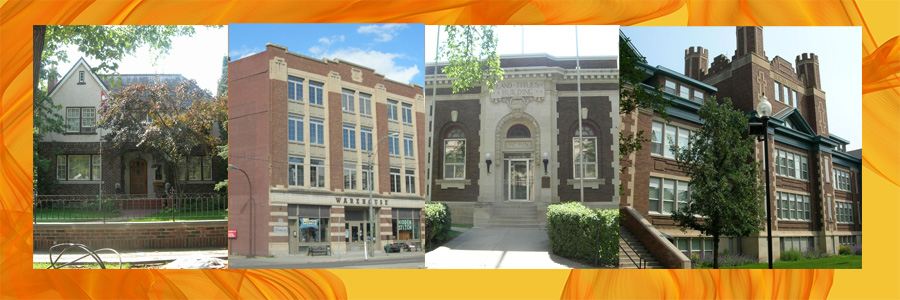Heritage Register
Discover. Explore. Celebrate.

The Saskatoon area has been inhabited for at least 8,000 years. Remnants of the past, such as teepee rings and medicine wheels, can still be seen today and form an important link with our history and the indigenous peoples of this Province.
Our community has changed dramatically since it was founded by the temperance colonists in the spring of 1883. From a small collection of sod shacks on the east bank of the South Saskatchewan River, Saskatoon has grown to be the largest city in Saskatchewan.
What is the Register?
Saskatoon is rich in heritage. The Saskatoon Register of Historic Places (Register) is an official listing of heritage resources identified by the City of Saskatoon as having significant heritage value or interest. It includes buildings, structures, monuments, memorials and natural and cultural landscapes that have helped shape our community and tell the story of Saskatoon.
Heritage resources included on the Register have been identified as having heritage significance for one (or a combination) of the following reasons:
- The resource is representative of a distinct or unique architectural style;
- The resource is associated with a significant person(s);
- The resource is attributed to a particular historical event or theme;
- The resource exhibits cultural, environmental, archeological or paleontological significance; and/or
- The resource adds value in the context of its surrounding area or landscape.
Please see the Register FAQ Sheet for more information on the Register.
Are Heritage Resources listed on the Register Protected?
Many of the heritage resources included in the Register have no legal protection. Those that have been protected and/or commemorated fall under one (or more) of the following categories:
- Holding Bylaw Property - provides short-term protection of a heritage resource from demolition by providing for a 60 day holding period in the event a demolition permit is received. Within that 60 day period heritage designation is considered by City Council.
- Municipal Heritage Property – designation by the City of Saskatoon to legally protect a heritage resource from demolition or unsympathetic alteration under The Heritage Property Act.
- Provincial Heritage Property – designation by the Province of Saskatchewan to legally protect a heritage resource from demolition or unsympathetic alteration under The Heritage Property Act.
- National Historic Site – commemoration by the Federal Government to recognize places of profound importance to Canada.
- Federal Heritage Railway Station Designation – designation by the Federal Government to protect railway stations from demolition and unsympathetic alteration under the Heritage Railway Stations Protection Act.
How Do I Use the Register?
The Register is categorized according to the original use or function of the heritage resource. Heritage resources are listed by their key name (which often correlates with either the original name or heritage value of the resource). Properties that are officially protected and/or recognized by the Municipal, Provincial or Federal Government are listed as designated. You may also view these properties on the Heritage Property Map.
Each Register listing is written in the form of a Statement of Significance (or SOS). A Statement of Significance consists of the following three components:
- A Description of the Historic Place – outlines what the historic place is;
- The Heritage Value of the Historic Place – explains why the historic resource is important, and;
- The Character Defining Elements of the Historic Place - describes what elements need to be conserved in order for the resource to retain its heritage value.
How Can I Submit a Request for a Heritage Resource to be Included on the Register?
Please contact us to make a request. All requests will be evaluated and approved at the discretion of the City and the Municipal Heritage Advisory Committee.
Getting Started
To get started simply click on one of the Heritage Register Categories listed below, or click on the button below to view the Heritage Register Interactive Map.
Disclaimer: The Saskatoon Register of Historic Places has no legal status and is for information purposes only. Although every effort is made to ensure the accuracy of information contained in the Register, information may be revised or updated without notice.
| Image | Building | Facility Type | Status |
|---|---|---|---|

|
19th Street Subway | Bridges and Infrastructure | Designated |

|
A.L. Cole Pumphouse | Bridges and Infrastructure | Regular |

|
Broadway Bridge | Bridges and Infrastructure | Holding Bylaw |

|
Canadian National (CN) Railway Bridge | Bridges and Infrastructure | Regular |

|
Canadian Pacific Railway (CPR) Bridge | Bridges and Infrastructure | Regular |

|
Canadian Pacific Railway (CPR) Station | Bridges and Infrastructure | Designated |

|
Five Corners | Bridges and Infrastructure | Regular |

|
Long Hill | Bridges and Infrastructure | Regular |

|
Short Hill | Bridges and Infrastructure | Regular |

|
Spadina Crescent Bridge | Bridges and Infrastructure | Regular |
